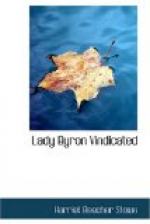’"Ed io, che posto son con
loro in croce
. . . . . e
certo
La fiera moglie, piu ch’altro,
mi nuoce.” {44}
’BYRON.
‘To Lady Byron.’
Two things are very evident in this correspondence: Lady Byron intimates that, if he publishes his story, some consequences must follow which she shall regret.
Lord Byron receives this as a threat, and says he doesn’t understand it. But directly after he says, ‘Before IT can take place, I shall be,’ etc.
The intimation is quite clear. He does understand what the consequences alluded to are. They are evidently that Lady Byron will speak out and tell her story. He says she cannot do this till after he is dead, and then he shall not care. In allusion to her accuracy as to dates and figures, he says: ’Be assured no power of figures can avail beyond the present’ (life); and then ironically advises her to anticipate the period,—i.e. to speak out while he is alive.
In Vol. VI. Letter 518, which Lord Byron wrote to Lady Byron, but did not send, he says: ’I burned your last note for two reasons,—firstly, because it was written in a style not very agreeable; and, secondly, because I wished to take your word without documents, which are the resources of worldly and suspicious people.’
It would appear from this that there was a last letter of Lady Byron to her husband, which he did not think proper to keep on hand, or show to the ‘initiated’ with his usual unreserve; that this letter contained some kind of pledge for which he preferred to take her word, without documents.
Each reader can imagine for himself what that pledge might have been; but from the tenor of the three letters we should infer that it was a promise of silence for his lifetime, on certain conditions, and that the publication of the autobiography would violate those conditions, and make it her duty to speak out.
This celebrated autobiography forms so conspicuous a figure in the whole history, that the reader must have a full idea of it, as given by Byron himself, in Vol. IV. Letter 344, to Murray:—
’I gave to Moore, who is gone to Rome, my life in MS.,—in seventy- eight folio sheets, brought down to 1816 . . . also a journal kept in 1814. Neither are for publication during my life, but when I am cold you may do what you please. In the mean time, if you like to read them you may, and show them to anybody you like. I care not. . . . ’
He tells him also:—
’You will find in it a detailed
account of my marriage and its
consequences, as true as a party
concerned can make such an account.’




